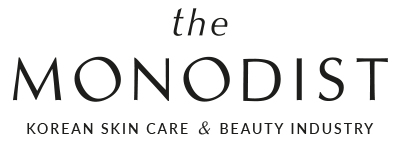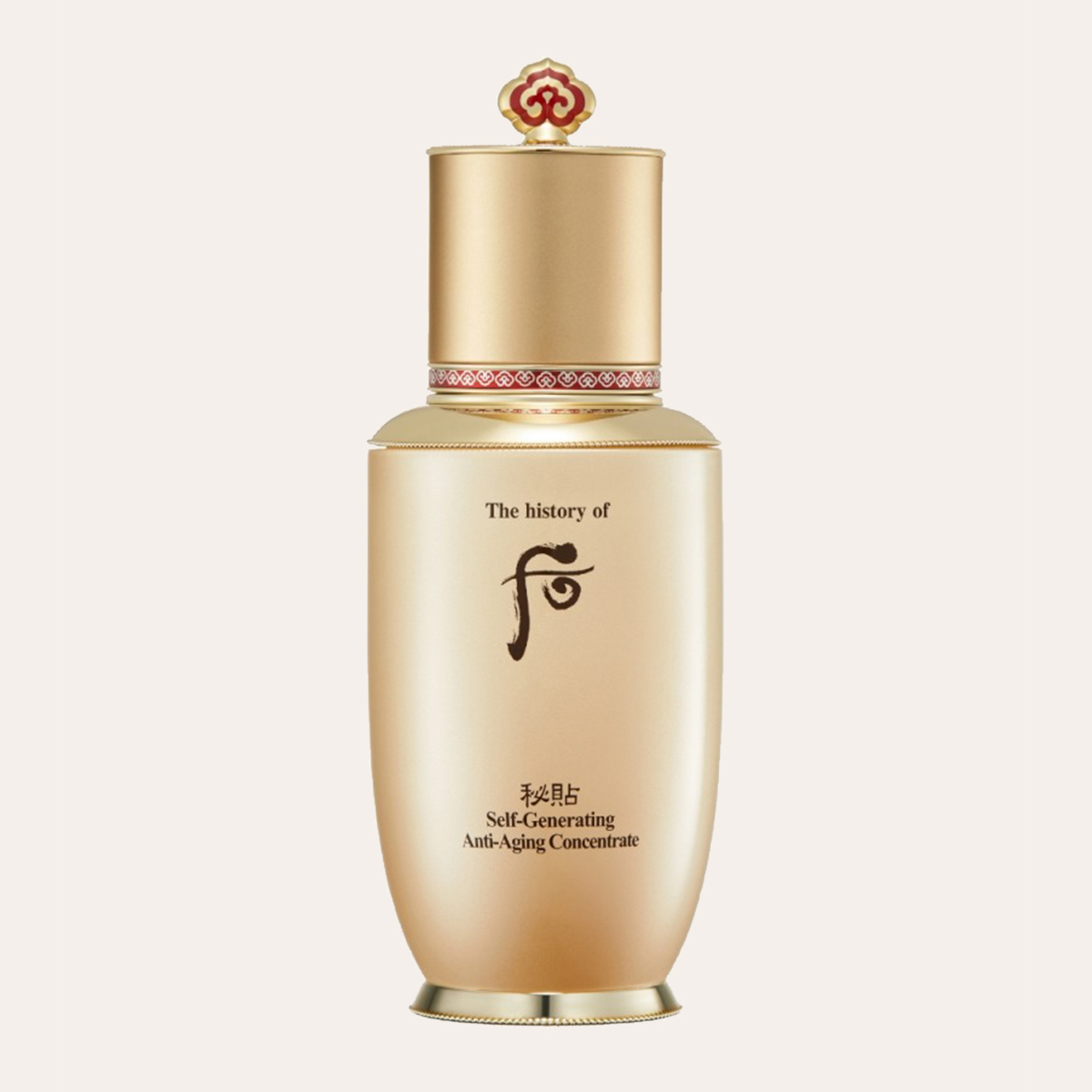
The History of Whoo – Bichup Self-Generating Anti-Aging Concentrate
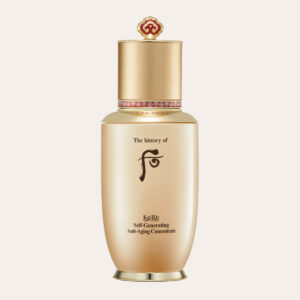
Please note that this product was reformulated in 2024. Click here for further information on the 2024 edition.
Product Info:
Brand: The History of Whoo
Product Name: Bichup Self-Generating Anti-Aging Concentrate
Korean Product Name: 비첩 자생 에센스
UV Protection: n/a
Capacity: 50ml
Formulated by: LG Household & Health Care
Manufactured by: LG Household & Health Care
Distributed by: LG Household & Health Care
Country of Manufacture: South Korea
Functional Cosmetic Certifications: Anti-Wrinkle
Original Retail Price: 165,000 KRW
Date of Release: August 2021
Shelf life: 3 years before opening. 12 months after opening.

Ingredients:
Notable allergens: Fragrance, Essential Oils, Alcohol.
Water, Glycerin, PEG/PPG/Polybutylene Glycol-8/5/3 Glycerin, Dipropylene Glycol, Glyceryl Polymethacrylate, Dimethicone, Butylene Glycol,1,2-Hexanediol, PEG-150, Methyl Trimethicone, Panthenol, Phenyl Trimethicone, Carthamus Tinctorius (Safflower) Flower Extract, Dioscorea Japonica Root Extract, Glycine Soja (Soybean) Oil, Glycyrrhiza Glabra (Licorice) Root Extract, Panax Ginseng Root Extract, Typha Angustifolia Spike Extract, Cinnamomum Cassia Bark Extract, Paeonia Lactiflora Root Extract, Ophiopogon Japonicus Root Extract, Theobroma Cacao (Cocoa) Seed Extract, Moringa Oleifera Seed Oil, Scutellaria Baicalensis Root Extract, Atractylodes Japonica Rhizome Extract, Cornus Officinalis Fruit Extract, Ziziphus Jujuba Fruit Extract, Cordyceps Militaris Mycelium Extract, Saposhnikovia Divaricata Root Extract, Zingiber Officinale (Ginger) Root Extract, Angelica Acutiloba Root Extract, Thymus Vulgaris (Thyme) Extract, Angelica Gigas Root Extract, Honey, Ethylhexylglycerin, Asparagus Cochinchinensis Root Extract, Polygonatum Officinale Rhizome/Root Extract, Polygonum Multiflorum Root Extract, Cordyceps Sinensis Mycelium Extract, Sodium Lactate, Ganoderma Lucidum (Mushroom) Extract, Hydroxyethylpiperazine Ethane Sulfonic Acid, Tetrasodium Glutamate Diacetate, Arginine, Rehmannia Chinensis Root Extract, Beta-Carotene, Daucus Carota Sativa (Carrot) Root Extract, Daucus Carota Sativa (Carrot) Seed Oil, Cedrol, Polysorbate 20, (Red) Panax Ginseng Root Extract, Sodium DNA, Potassium Aspartate, Angelica Gigas Extract, Nelumbium Speciosum Flower Extract, Nuphar Japonicum Root Extract, Tryptophan, Arbutin, Asparagine, Astragalus Membranaceus Root Extract, Biotin/Folic Acid/Cyanocobalamin/Niacinamide/Pantothenic Acid/Pyridoxine/Riboflavin/Thiamine/Yeast Polypeptides, Glutamine, Potassium Sorbate, Proline, Alanine Glutamate, Glycine, Threonine, Phellodendron Amurense Bark Extract, Sodium Hyaluronate, Lysine, Serine, Oligopeptide-1, Glycosphingolipids, Valine, Leucine, Phenylalanine, Tyrosine, Acetyl Hexapeptide-8, Copper Tripeptide-1, Oligopeptide-4, Poria Cocos Sclerotium Extract, Phospholipids, Oligopeptide-2, Isoleucine, Histidine, Hydrolyzed Soy Protein, Ascorbyl Palmitate, Palmitoyl Tripeptide-1, Palmitoyl Tetrapeptide-7, Histidine HCl, Methionine, Quercetin, Inositol, Cystine, Folic Acid, Pyridoxine HCl, Thiamine HCl, Calcium Pantothenate, Biotin, Riboflavin, Cyanocobalamin, Cyclopentasiloxane, Propylene Glycol, Polymethylsilsesquioxane, Hydrogenated Lecithin, Dipalmitoyl Hydroxyproline, C14-22 Alcohols, Squalane, PEG-60 Hydrogenated Castor Oil, Ceramide NP, Tromethamine, Macadamia Ternifolia Seed Oil, Triethylhexanoin, Carbomer, Eclipta Prostrata Extract, Dimethiconol, PEG-10 Rapeseed Sterol, Arachidyl Glucoside, Butyrospermum Parkii (Shea) Butter, Algin, PEG-40 Hydrogenated Castor Oil, Sodium Polyacrylate, Caprylic/Capric Triglyceride, Glyceryl Stearate, Acrylates/C10-30 Alkyl Acrylate Crosspolymer, Empetrum Nigrum Fruit Juice, Helianthus Annuus (Sunflower) Seed Oil, Stearic Acid, Biosaccharide Gum-1, Tocopherol, Melia Azadirachta Leaf Extract, Dextrin Palmitate, Cholesterol, PEG-100 Stearate, Niacinamide, Beta-Glucan, Glycereth-20, Trisodium EDTA, Fragrance, Geraniol, Linalool, Benzyl Salicylate, Citronellol, Limonene, Hydroxycitronellal, Alpha-Isomethyl Ionone
정제수, 글리세린, 피이지/피피지/폴리부틸렌글라이콜-8/5/3글리세린, 다이프로필렌글라이콜, 글리세릴폴리메타크릴레이트, 다이메티콘, 부틸렌글라이콜, 1,2-헥산다이올, 피이지-150, 메틸트라이메티콘, 판테놀, 페닐트라이메티콘, 잇꽃꽃추출물, 참마뿌리추출물, 돌콩오일, 스페인감초뿌리추출물, 인삼추출물, 애기부들이삭추출물, 육계나무껍질추출물, 작약뿌리추출물, 소엽맥문동뿌리추출물, 카카오씨추출물, 드럼스틱씨오일, 황금추출물, 삽주뿌리줄기추출물, 산수유열매추출물, 대추추출물, 밀리타리스동충하초추출물, 방풍뿌리추출물, 생강추출물, 왜당귀뿌리추출물, 타임추출물, 참당귀뿌리추출물, 꿀, 에틸헥실글리세린, 천문동뿌리추출물, 각시둥굴레뿌리줄기/뿌리추출물, 하수오뿌리추출물, 동충하초추출물, 소듐락테이트, 영지버섯추출물, 하이드록시에틸피페라진에탄설포닉애씨드, 소듐글루타메이트, 알지닌, 지황뿌리추출물, 베타-카로틴, 당근추출물, 당근씨오일, 세드롤, 폴리솔베이트20, 홍삼추출물, 소듐디엔에이, 포타슘아스파테이트, 참당귀추출물, 연꽃꽃추출물, 연꽃뿌리추출물, 트립토판, 알부틴, 아스파라진, 황기뿌리추출물, 비오틴/폴릭애씨드/시아노코바라민/니아신아마이드/판토테닉애씨드/피리독신/리보플라빈/티아민/효모폴리펩테이드, 글루타민, 포타슘솔베이트, 프롤린, 알라닌, 글라이신, 트레오닌, 황벽나무껍질추출물, 소듐하이알루로네이트, 라이신, 세린, 올리고펩타이드-1, 글라이코스핑고리피드, 발린, 류신, 페닐알라닌, 타이로신, 아세틸헥사펩타이드-8, 카퍼트라이펩타이드-1, 올리고펩타이드-4, 복령균핵추출물, 포스포리피드, 올리고펩타이드-2, 아이소류신, 히스티딘, 하이드롤라이즈드콩단백질, 아스코빌팔미테이트, 팔미토일트라이펩타이드-1, 팔미토일테트라펩타이드-7, 히스티딘에이치씨엘, 메티오닌, 쿼세틴, 이노시톨, 시스틴, 폴릭애씨드, 피리독신에이치씨엘, 티아민에이치씨엘, 칼슘판토테네이트, 바이오틴, 리보플라빈, 사이아노코발아민, 사이클로펜타실록세인, 프로필렌글라이콜, 폴리메틸실세스퀴옥세인, 하이드로제네이티드레시틴, 하이드록시프롤린, C14-22알코올, 스쿠알란, 피이지-60하이드로제네이티드캐스터오일, 세라마이드엔피, 트로메타민, 마카다미아씨오일, 트라이에틸헥사노인, 카보머, 한련초추출물, 다이메티콘올, 피이지-10레이프씨드스테롤, 아라키딜글루코사이드, 시어버터, 알진, 피이지-40하이드로제네이티드캐스터오일, 소듐폴리아크릴레이트, 카프릴릭/카프릭트라이글리세라이드, 글리세릴스테아레이트, 아크릴레이트/C10-30알킬아크릴레이트크로스폴리머, 시로미열매즙, 해바라기씨오일, 스테아릭애씨드, 바이오사카라이드검-1, 토코페롤, 인도멀구슬나무잎추출물, 덱스트린, 콜레스테롤, 피이지-100스테아레이트, 나이아신아마이드, 베타-글루칸, 글리세레스-20, 트라이소듐이디티에이, 향료, 제라니올, 리날룰, 벤질살리실레이트, 시트로넬올, 리모넨, 하이드록시시트로넬알, 알파-아이소메틸아이오논

Product Description:
The “Bichup Self-Generating Anti-Aging Concentrate” is the representative anti-aging serum of The History of Whoo. The product has been a steady best-seller for a long time, ranking first in the anti-aging essence category for over 10 years in Korea (source: Kantar Worldpanel 2011-2021).
It’s a complete anti-aging treatment that enhances the skin’s self-regenerating power to tackle both visible and underlying signs of aging.
Through clinical trials, it was shown that the application of the product:
- Improves skin barrier damage by 65.1% after just 3 days of use (Testing Organisation: Ellead. Participants: 32 women aged 20-61 years. Period: from May 10 to 18 2021).
- Increases skin density by 26.5% after 4 weeks of use (Testing Organisation: Global Medical Research Center. Participants: 32 women aged 27-43 years. Period: from May 13 to June 11 2021).
- Reduces underlying wrinkles by 10.5% after 4 weeks of use (Testing Organisation: Global Medical Research Center. Participants: 32 women aged 27-43 years. Period: from May 13 to June 11 2021).
- Improves elasticity in the deep layers of the skin by 12.1% (Testing Organisation: Global Medical Research Center. Participants: 32 women aged 27-43 years. Period: from May 13 to June 11 2021).
- Provides 25% quicker results compared to the previous formulation. (Testing Organisation: Ellead. Participants: 33 women aged 42-60 years. Period: from May 26 to June 23 2021).
In particular, the “Bichup Self-Generating Anti-Aging Concentrate” contains 5 precious ingredients that provide a complete 5-step system to target even the most complex aspects of skin aging:

- Step 1: Mitigate.
Royal Bowondan improves micro-aging to prevent underlying signs of aging from becoming visible. - Step 2: Refine.
Through a senolytic action, Yoonseolran selectively eliminates senescent cells so that the benefits of the formula can only be absorbed by healthy cells. - Step 3: Revitilise.
Cordycepin extracted from Cordyceps Militaris energizes and reinvigorates aging skin. - Step 4: Boost.
Jahabichup Complex™ supplies nutrients to the skin to enhance its self-regenerating ability. - Step 5: Protect.
Lotus Flower provides skin barrier support and protects skin from external aggressors that contribute to premature aging, including free radicals.
⬥ Jahabichup Complex™ (자하 비첩 Complex™, 蕴含紫河秘贴 Complex™)
“Jahabichup Complex™” (자하 비첩 Complex™, 蕴含紫河秘贴 Complex™) is a proprietary ingredient that revives complexion and enhances skin’s self-regenerating power.
The ingredient is the result of 15 years of research using the latest data mining technology. Through data mining, LG Household & Health Care analysed 20 million studies to discover the best traditional ingredients that could deliver the desired effects.
“Jahabichup Complex™” is a potent combination of vitamins, yeast polypeptides, amino acids, oligopeptides, growth factors and many more. One of its core components is Chojahabidan, a plant placenta derivative that enhances the skin’s self-healing power.
The ingredient was inspired by Jahageo (자하거, 紫河車), also known as Hominis Placenta, a traditional royal remedy used to treat Qi (vital energy) deficiency and, in turn, reinvigorate the body. The Donguibogam, the most representative text of Traditional Korean Medicine, describes the Jahageo as follows:
It’s used to cure emaciated individuals that are lacking vital energy and nutrition, weak individuals with a body exhausted by overwork, and those who suffer from skin pigmentary changes and melasma.
DONGUIBOGAM (1613)1
“Jahabichup Complex™” also includes 3 potent royal remedies.

After studying numerous royal records and traditional Oriental Medicine texts, researchers at LG Household & Health Care identified the 3 main herbal prescriptions used to look after the health of Eastern royals: Gongjindan (공진단, 拱辰丹), Kyungokgo (경옥고, 瓊玉膏) and Cheongsimwon (청심원, 淸心元).
Researchers combined these traditional formulas with modern dermatological science to obtain 3 innovative cosmetic ingredients:
- Gongjinbidan (공진비단, 供辰秘丹).
- Gyeongokbidan (경옥비단, 瓊玉秘丹).
- Cheongsimbidan (청심비단, 淸心秘丹).
For details on Gongjinbidan, please refer to the main page of the Bichup line.
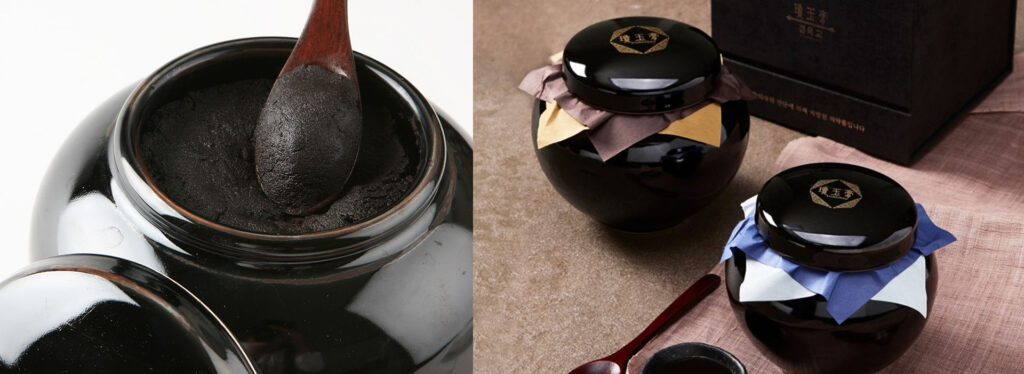
Gyeongokbidan (경옥비단, 琼玉精萃) is a modern reinterpretation of Gyeongokgo (경옥고, 瓊玉膏), one of the 3 main restorative remedies recorded in the Donguibogam5. Gyeongokgo is also known as “Noblemen’s medicine”6 because in the past it used to be a prescription reserved for nobles and members of the royal court.
Gyeongokgo, also known as “Precious Jade Paste” is originally used to treat chronic fatigue and emaciation related to Lung Qi and Yin Deficiency5 .
In Oriental Medicine, Lung Qi regulates the preservation or excretion of fluids through the skin, and consequently the opening and closing of the skin pores. As a result, when Lung Qi is deficient, pores appear excessively open. On the other hand, Yin deficiency manifests through a generalised dryness across all vital organs, skin included.
Through the application of a proprietary technology, LG Household & Health Care developed a cosmetic ingredient based on the original prescription for Gyeongokgo: Gyeongokbidan.
Gyeongokbidan rebalances Lung Qi and Yin and helps smooth skin texture by replenishing moisture and reducing the appearance of pores.
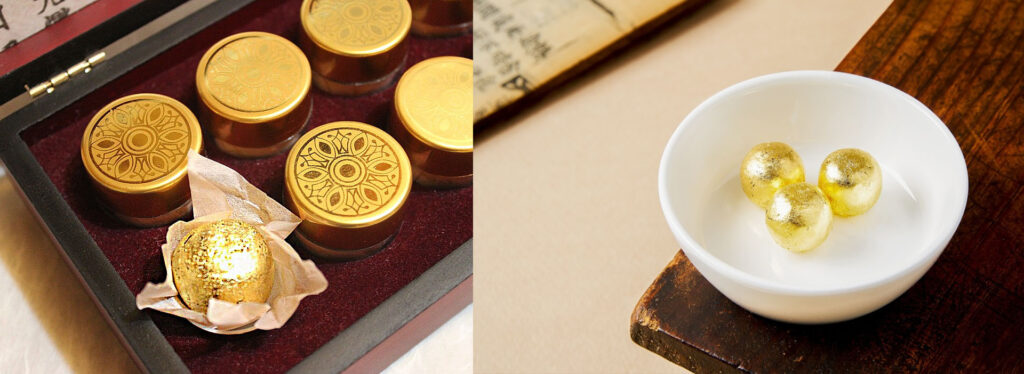
Cheongsimbidan (청심비단, 淸心秘丹) is based on classic Korean herbal remedy Cheongsimwon (청심원, 淸心元), a prescription used to reduce excess heat in the Heart and the Liver and, in turn, treat cardiovascular conditions. As a cosmetic ingredient Cheongsimbidan acts as a detoxifying remedy that relieves redness, soothes irritation, eliminates impurities and rebalances skin.
Overall, “Jahabichup Complex™” was developed to mimic the effects of human placenta (Jahageo) and enhance skin’s natural ability to identify and repair its own weaknesses, promoting self-healing and skin regeneration. Thanks to its multifunctional formula, the ingredient provides a complete anti-aging treatment that reinvigorates skin, boost self-regeneration, reduces the appearance of wrinkles, enhances elasticity, and boosts skin radiance.
⬥ Royal Bowondan (궁중보원단)
“Royal Bowondan” is a combination of 3 traditional royal remedies (Samjibowonboeb, 삼지보원법) used to tonify the body and treat underlying health conditions. Please note that in Oriental Medicine, “Tonification” is a therapy used to rebalance the body and replenish its vital energy. [T/N there is no correspondence between Oriental Medicine organs and Western anatomy, so in this context capitalised names are not to be intended in the anatomical sense. For more information, please refer to the introduction to Oriental Medicine on this website]
In particular, “Royal Bowondan” is a blend of:
- Paljintang (팔진탕, 八珍湯) – used to treat Lung Qi Deficiency, Spleen Qi Deficiency and Blood and Qi Deficiency. Enhances immunity,events moisture loss, replenishes Qi (vital energy) and improves circulation by nourishing Blood.
- Guibitang (귀비탕, 歸脾湯) – used to treat Heart and Spleen Qi deficiency, as well as chronic Qi and Blood deficiency, Replenishes Qi (vital energy), reinvigorates body, improves circulation by nourishing Blood and tonifies Heart and Spleen.
- Liuwei Dihuang (육미지황환, 六味地黃丸) – used to restore declined functions related to aging.
Together, “Royal Bowondan” works to mitigate micro-aging and prevent underlying signs of aging from becoming visible.

⬥ Yoonseolran (윤설란)
Yoonseolran is a skin refining ingredient extracted from Black Crowberry (Empetrum nigrum L.). The plant is naturally rich in Quercetin, a substance with senolytic properties that induces apoptosis of aging cells.
⬥ Cordycepin (동충하초 코디세핀, 冬虫夏草)
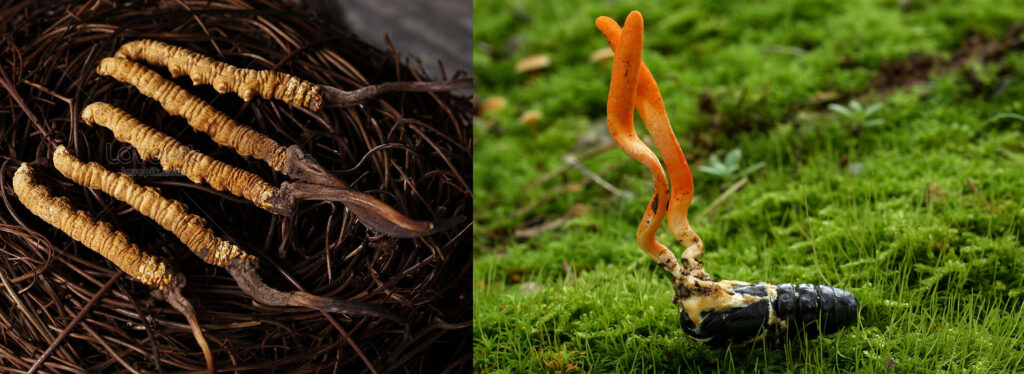
Cordyceps Militaris is a parasitic fungus used in Oriental Medicine for its wide range of pharmacological effects, including: anti-tumoral, immunomodulatory, anti-inflammatory and reinvigorating properties. Much like Wild Ginseng, it’s a naturally scarce ingredient, which lead it to become the world’s most expensive fungus, with prices going up even to $140,000 per kg2. It is said that numerous Chinese leaders, from ancient emperor Qin Shi Huang to Yang Guifei enjoyed the miracles properties of this mushroom3.
Cordycepin is the main bioactive compound found in Cordyceps Militaris. It works to energise and rejuvenate skin by improving cell senescence4.
⬥ Lotus Flower (연꽃, 莲花萃取物)
Lotus Flower is a traditional herbal remedy that is known for its outstanding antioxidant properties. The plant promotes a healthy-looking complexion by combating free radicals, reducing inflammation, repairing oxidative damage caused by environmental aggressors like UV rays, and supporting skin barrier function to prevent moisture loss.
⬥ Trivia

- The primary packaging was inspired by the sinuous curves of the White Porcelain Placenta Jar, National Treasure No. 1055 (국보 제1055호 “백자 태항아리”).
- The secondary packaging was inspired by the “Jewelry Box with Lotus and Peony Design of the Consort of Imperial Prince Yeong”.
- Every year The History of Whoo releases a special limited edition of their “Bichup Self-Generating Anti-Aging Concentrate” with a packaging inspired by a different traditional Korean artwork.

Directions:
Use right after prepping skin with a toner to ensure deep absorption into the skin. Carefully distribute the product along the natural texture of your skin, starting from the cheeks, forehead, nose, and chin in that order. Lightly wrap your face with your palms to aid quick absorption.

Precautions:
Discontinue use if irritation or rash occurs while using the product or in case symptoms appear by direct sunlight after using the product. Consult a physician if irritation persists. Do not use the product on broken or damaged skin. Keep out of reach of children. Do not store at extreme temperatures or in direct sunlight. Do not use for other than intended purpose. Only use as directed. Be careful not to get the product in your eyes. After use, do not put the remaining product back into the container. Do not mix with any other substances or products. Be careful not to get the product on your clothes. For external use only.

Other editions and formulations:
⬥ Previous formulations:
- Bichup Self-Generating Anti-Aging Essence [launched: August 2016, formulated and manufactured by: LG Household & Health Care]
- Bichup Ja Saeng Essence [launched: October 2009, formulated and manufactured by: LG Household & Health Care]
⬥ Special limited editions:
TBC

Shop:
⬥ International retailers:
Make sure to check out the Discount & Coupons page to access exclusive offers for major Korean skincare retailers.
⬥ South Korean retailers:

Reviewed by Odile?

Notes:
1. 김경동. (2005). “혼돈시대의 강정제 “자하거(紫河車).”” 신동아.
2. Hou, David Anderson, Chia-Yi. (2021). “The World’s Most Valuable Parasite, Caterpillar Fungus, Can Cost up to $63,000 per Pound.” Business Insider.
3. KBS World. (2019). “BIOARA Dreams of Becoming the World’s Leading Cordyceps Provider.”
4. Kim, Hyo Jin et al. (2015) “Suppression of Cellular Senescence by Cordycepin in Replicative Aged Human Dermal Fibroblasts,” Journal of the Society of Cosmetic Scientists of Korea. 대한화장품학회, 41(2), pp. 135–141. doi: 10.15230/SCSK.2015.41.2.135.
5. 김태인. (2020). “Gyeongokgo Is Known to Rejuvenate Our Body and Strengthen Immunity – 월간파워코리아.” Power Korea
6. Haejuclinic. (n.d). “Haeju Gyeongokgo.” Retrieved 25 May 2022 from http://en.haejuclinic.com/product/gyeongokgo/
Source: The History of Whoo official website
Translation: © 2022 Odile Monod
Disclaimer: The list above contains a combination of affiliate and non-affiliate links. If you make a purchase through one of my affiliate links, I will earn a small commission (paid by third party companies, not you). Commissions help fund the content production of the Monodist. For more information on my affiliate policy please refer to my About page. Some links are missing because the item is not available outside of Korea at the moment.
